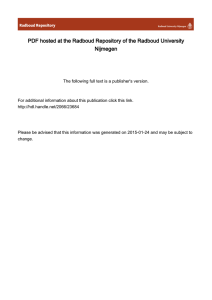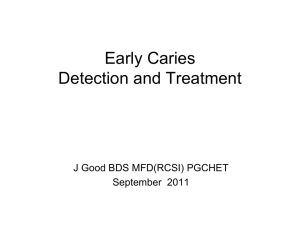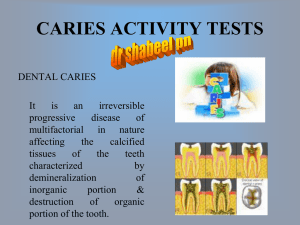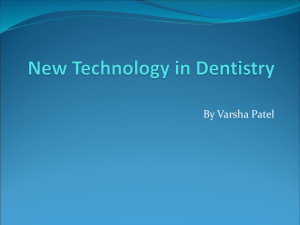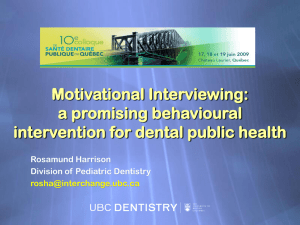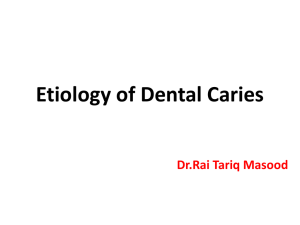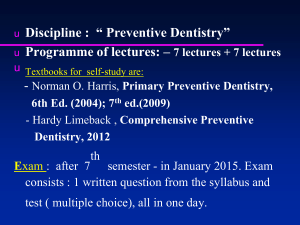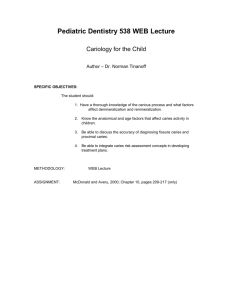Methods of Caries Well-Timed Diagnostics X
advertisement
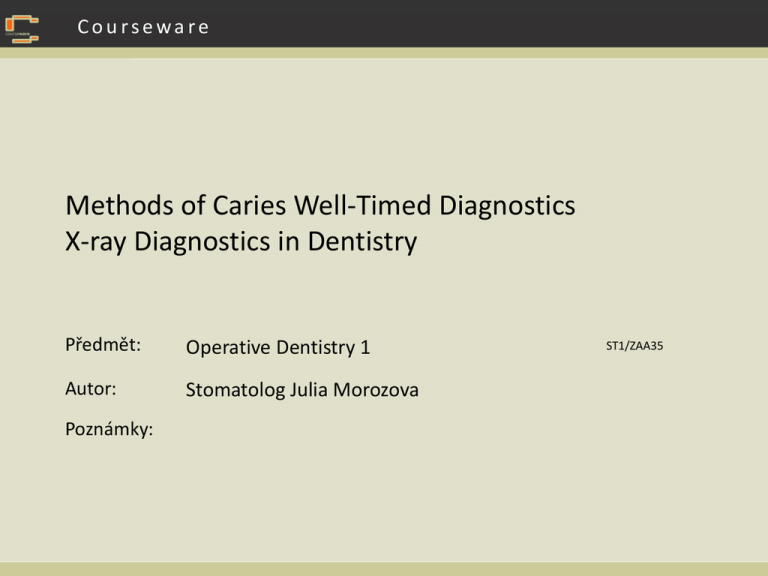
Courseware Methods of Caries Well-Timed Diagnostics X-ray Diagnostics in Dentistry Předmět: Operative Dentistry 1 Autor: Stomatolog Julia Morozova Poznámky: ST1/ZAA35 Caries well-timed diagnostics • Diagnostics of initial stages of dental caries • Primary prevention- without preparation • Secondary prevention- minimal invasive meausures Caries incipiens: clinical symptoms • Focus of enamel demineralization • White spot • Surface layer of enamel is maintained Methods of caries well-timed diagnostics • Common: • Visual-tactile • Transillumination using dental mirror and source of light • Detection using dyes • With special equipment • • • • • • • Radiographic diagnostics Laser Fluorescence Quantitative Light-Induced Fluorescence Fiber Optic Trasillumination Digital Image Fiber Optic Transillumination Electronic Caries Monitor Ultrasonic detection Methods of caries well-timed diagnostics (requiring special equipment) Physical effect Application in caries diagnostics X-rays RTG, RVG, CBCT, CBVT Laser fluorescence Laser detection of caries (DIAGNOdent) Electricity Electronic Caries Monitor (ECM) Ultrasound Ultrasonic detection of caries Light with different wavelength Quantitative Light-induced Fluorescence (QLF) Fiber Optic Transillumination (FOTI) (Dia Lux) Digital Image Fiber Optic Transillumination (DIFOTI) (DIAGNOcam) Visual-tactile assessment • • • • • Clean and dry tooth surface Dental mirror Dental probe Perfect illumination Magnification Transillumination using dental mirror and light from unit • For approximal surfaces of frontal teeth Detection using dyes Use: • Caries detection • Detection of necrotic tissues during preparation (dye is connected with irreversibly destructured collagen fibers) • Finding of root canal entrances in endodontics • Detection of tooth cracks Radiographic examination • • • • Intraoral radiograms Bite-wing (interproximal) projection Ortopantomogram Cone beam volumetric tomography Parallel technique of radiogram making • • The radiogram is the most close to the real situation in the mouth (isometric orthoradial) It requares the use of special holders Carious lesion • Clearing with different size • Approximal, fissural, root, secondary (reccurent) carious lesions • It is not deciding examination method for vestibular, oral or occlusal lesions • The most suitable is the bite-wing technique (premolar, molar) Bite-wing radiograms evaluation • D1 -clearing is in the outer half of the enamel • D2 -clearing is in the inner half of the enamel • D3 -clearing goes upto enamel-dentin junction • D4 –clearing is in dentin Laser Fluorescence (DIAGNOdent) • Red light at a wavelength of 655 nm • Sound hard dental tissues do not react to this wavelength • Metabolites from cariogennic bacteria create an infrared fluorescence • In special device (DIAGNOdent, KaVo, Germany; Hibst, Gall, late 1990s) the emitted light is channelled through the handpiece and presented as a number on a display DIAGNOdent- working procedure • Careful cleaning of tooth surface • Drying by air stream • Calibration of the device by application onto sound enamel • Measuring • Allows to detect carious lesions on the smooth, occlusal as well as approximal surfaces DIAGNOdent- criteria for evaluation 0–4 Sound enamel or caries incipiens (D1) 4 – 10 Decay of inner layer of enamel without damage of enamel-dentin junction (D2) 10 – 18 Decay of external layer of dentin (D3) >18 Extensive decay of inner layer of dentin (D4) *A.Lussi, S. Imwinkelried, N.B. Pitts, C. Longbottom, E. Reich. Performance and Reproducibility of a Laser Fluorescence System for Detection of Occlusal Caries in vitro. Caries Res. 1999;33(4):261–266 Quantitative Light-induced Fluorescence (QLF) • Uses the phenomenon of tooth auto fluorescence • Primary diagnostics as well as check up of necrotic tissues removing • Soprolife (ActeonGroup, France); InspektorTM Pro (Inspektor Dental Care, Amsterdam, The Netherlands) Fiber Optic Transillumination (FOTI) • Uses light transmission through the tooth • Demineralized dental hard tissues scatter and absorb light more than sound tissue • For enamel and dentin caries detection on occlusal, approximal and smooth surfaces of anterior and posterior teeth (carious lesions appear darker compared to sound tissue) • Dia Lux (KaVo, Germany) Digital Imaging of Fiber Optic Transillumination (DIFOTI) • Uses the same principles like FOTI • White light is delivered through an optical fiber via handpiece channelling the image back to a digital camera and visualizing the image on a monitor via computer system • DIAGNOcam (KaVo, Germany) DIFOTI (DIAGNOcam): principle of working • Light with wave length 780 nm • Tooth is light conductor • Digital camera makes black-and-white record on the computer display • Tooth decay looks like dark shade DIFOTI: contraindications, limits of using • • • • Large fillings Crowns Subgingival localization of tooth decay Calculus or tooth discoloration can lead to light scattering and can be shown like shade DIFOTI: possibilities • Primary carious lesions (occlusal and approximal) esp. on distal teeth • Caries reccurent (upto definite depth) • Cracks or imperfections in supragingival regio Electronic Caries Measurement (ECM) • Sound dental hard tissue shows very high electrical resistance or impedance • Demineralized enamel has lower resistance • Ground-unit • Handpiece • The result is presented on a display as a number between 1 and 13 Alternating Current Impedance Spectroscopy (ACIST) • It is based on the same principle of electrical proud as the ECM • It measures resistance, continuous conduction as well as transverse conductance • CarieScanTM (IDMoS PLC, Dundee, UK) Ultrasound diagnostics (Ultrasonic Caries Detector- UCD) • Sound waves can pass through gases, liquids and solids and boundaries between them • Images of tissues can be acquired by collecting of the reflected sound waves • Ultrasonic probe allows to examine inaccessible places • UCD (Novadent Ltd., Lod, Israel) THANK YOU FOR ATTENTION
